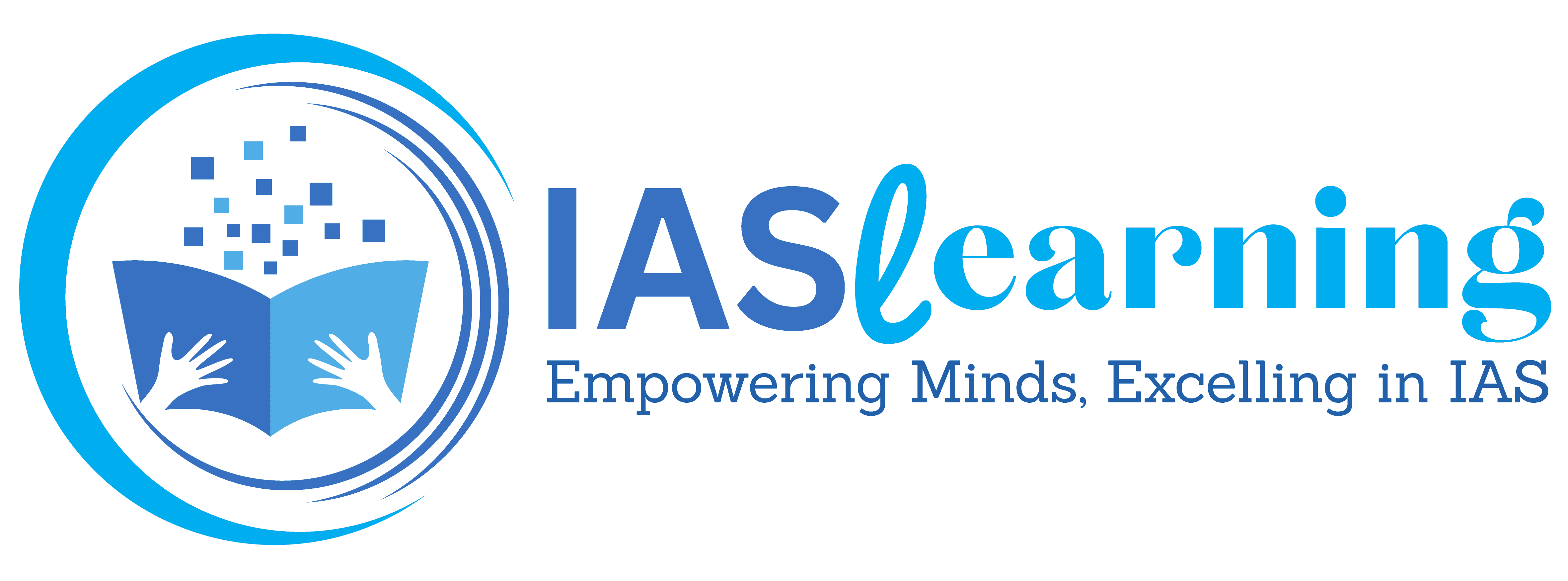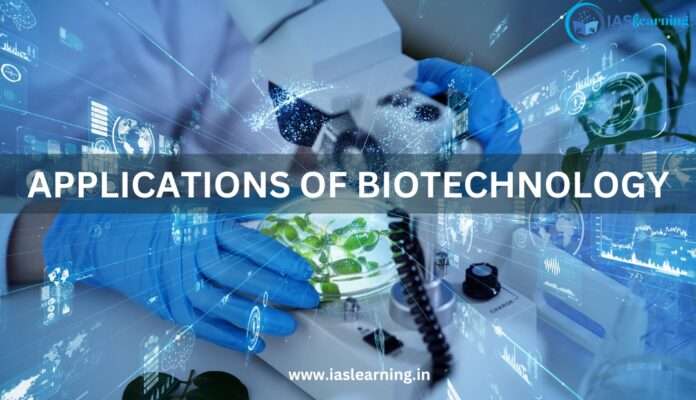Introduction: Applications of Biotechnology
- Biotechnology is technology that utilizes biological systems, living organisms or parts of this to develop or create different products. For example, Brewing and baking bread are examples of processes that fall within the concept of biotechnology.
- Such traditional processes usually utilize the living organisms in their natural form (or further developed by breeding), while the more modern form of biotechnology will generally involve a more advanced modification of the biological system or organism.
- With the development of genetic engineering in the 1970s, research in biotechnology (and other related areas such as medicine, biology etc.) developed rapidly because of the new possibility to make changes in the organisms’ genetic material (DNA).
- Biotechnology deals with industrial scale production of biopharmaceuticals and biologicals using genetically modified microbes, fungi, plants and animals.
- The applications of biotechnology include therapeutics, diagnostics, genetically modified crops for agriculture, processed food, bioremediation, waste treatment, and energy production.
Applications of Biotechnology: Principles
- Genetic Engineering: Techniques to alter the chemistry of genetic material to introduce into host organism and thus change the phenotype of organism
- The genotype is a set of genes in DNA responsible for unique traits or characteristics while the phenotype is the physical appearance or characteristic of an organism.
- Bioprocess Engineering: Maintenance of sterile (microbial contamination-free) ambience in chemical engineering processes to enable growth of only the desired microbe/eukaryotic cell in large quantities for the manufacture of biotechnological products like antibiotics, vaccines, enzymes, etc.
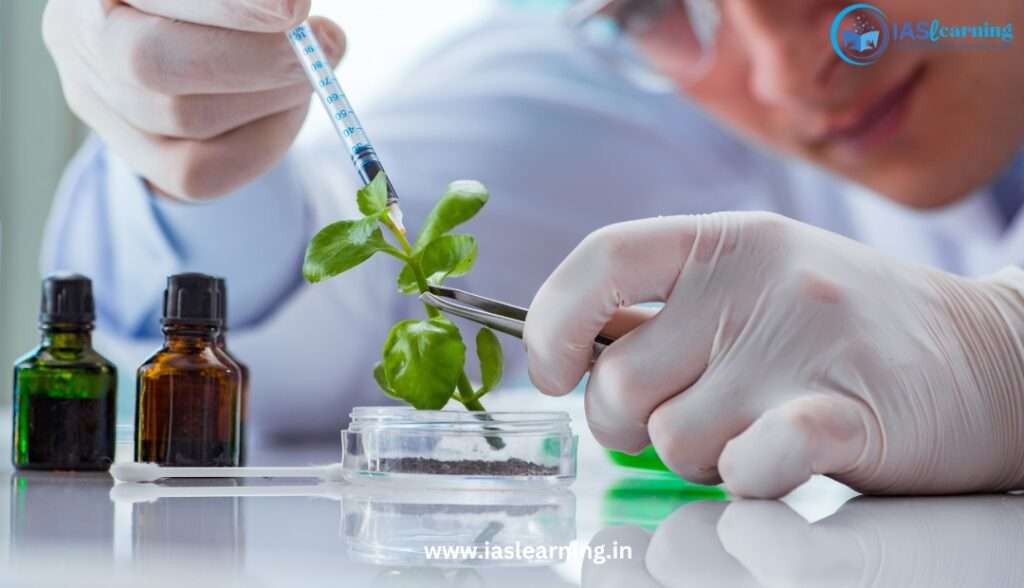
Applications of Biotechnology: Branches
A series of derived terms have been pointed out to identify several branches of Biotechnology such as:
- Bioinformatics: It is an interdisciplinary field that addresses biological problems using computational techniques and makes rapid organization and analysis of biological data possible.
- Blue Biotechnology: It is the term that has been used to describe the marine and aquatic applications of Biotechnology, but its use is relatively rare.
- Green Biotechnology: Biotechnology in agriculture has proved to be revolutionary and researchers are still in the process. e.g., BT cotton (micropropagation).
- Red Biotechnology: Red Biotechnology is applied in the medical process. For example, The development of organisms capable of producing antibiotics and Genetic engineering for genetic manipulation.
- White Biotechnology: It is also known as industrial Biotechnology or Biotechnology applied to industrial processes.
Applications of Biotechnology in Agriculture
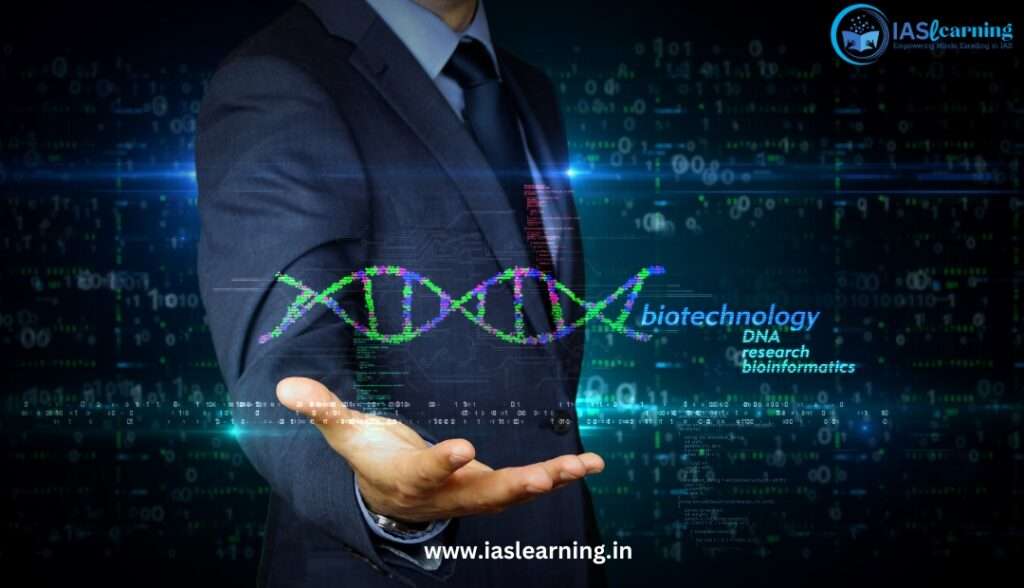
- Alternative of conventional farming: Use of genetically modified crops is a possible solution. It is an alternative path to conventional farming.
- The understanding of genetics could enable farmers to obtain maximum yield from their fields and to minimise the use of fertilisers and chemicals so that their harmful effects on the environment.
- Genetically Modified Organisms (GMO): Plants, bacteria, fungi and animals whose genes have been altered by manipulation are called Genetically Modified Organisms (GMO). GM plants have been useful in many ways. Genetic modification has:
- Made crops more tolerant to abiotic stresses (cold, drought, salt, heat).
- Reduced reliance on chemical pesticides (pest-resistant crops).
- Helped to reduce post-harvest losses.
- Increased efficiency of mineral usage by plants (this prevents early exhaustion of fertility of soil).
- Enhanced nutritional value of food, e.g., golden rice, i.e., Vitamin ‘A’ enriched rice.
- Genetically modified biopesticide: Bt toxin is produced by a bacterium called Bacillus thuringiensis (Bt for short).
- Bt toxin gene has been cloned from the bacteria and been expressed in plants to provide resistance to insects without the need for insecticides.
- In effect created a bio-pesticide. Examples are Bt cotton, Bt corn, rice, tomato, potato and soyabean etc. Bt Cotton.
- Some strains of Bacillus thuringiensis produce proteins that kill certain insects such as lepidopterans (tobacco budworm, armyworm), coleopterans (beetles) and dipterans (flies, mosquitoes).
- B. thuringiensis forms protein crystals during a particular phase of their growth. These crystals contain a toxic insecticidal protein.
- Pest resistant plants: Several nematodes parasitise a wide variety of plants and animals including human beings.
- A nematode Meloidogyne incognita infects the roots of tobacco plants and causes a great reduction in yield.
- A novel strategy was adopted to prevent this infestation which was based on the process of RNA interference (RNAi).
- RNAi takes place in all eukaryotic organisms as a method of cellular defense.
- This method involves silencing of a specific mRNA due to a complementary dsRNA molecule that binds to and prevents translation of the mRNA (silencing).
Applications of Biotechnology in Medicine

- The recombinant DNA technological processes have made immense impact in the area of healthcare. It enables mass production of safe and more effective therapeutic drugs.
- The recombinant therapeutics do not induce unwanted immunological responses as is common in case of similar products isolated from non-human sources.
- Genetically Engineered Insulin: Management of adult-onset diabetes is possible by taking insulin at regular time intervals.
- Insulin consists of two short polypeptide chains: chain A and chain B, that are linked together by disulphide bridges.
- In mammals, including humans, insulin is synthesised as a prohormone.
- Like a pro-enzyme, the pro-hormone also needs to be processed before it becomes a fully mature and functional hormone) which contains an extra stretch called the C peptide.
- C peptide is not present in the mature insulin and is removed during maturation into insulin.
- The main challenge for production of insulin using rDNA techniques was getting insulin assembled into a mature form.
- Gene Therapy: If a person is born with a hereditary disease, can corrective therapy be taken for such a disease. Gene therapy is an attempt to do this.
- Gene therapy is a collection of methods that allows correction of a gene defect that has been diagnosed in a child/embryo.
- Genes are inserted into a person’s cells and tissues to treat a disease.
- Correction of a genetic defect involves delivery of a normal gene into the individual or embryo to take over the function of and compensate for the non-functional gene.
- Curing adenosine deaminase (ADA) deficiency: Adenosine deaminase enzyme is crucial for the immune system to function.
- This disorder is caused due to the deletion of the gene for adenosine deaminase.
- Through gene therapy, lymphocytes from the blood of the patient are grown in a culture outside the body.
- A functional ADA cDNA (using a retroviral vector) is then introduced into these lymphocytes, which are subsequently returned to the patient.
- However, the patient requires periodic infusion of such genetically engineered lymphocytes.
- If the gene isolate from marrow cells producing ADA is introduced into cells at early embryonic stages, it could be a permanent cure.
- Molecular Diagnosis
- For effective treatment of a disease, early diagnosis and understanding its pathophysiology is very important.
- Using conventional methods of diagnosis (serum and urine analysis, etc.) early detection is not possible. Some of the techniques that serve the purpose of early diagnosis are:
- Recombinant DNA technology,
- Polymerase Chain Reaction (PCR) and
- Enzyme Linked Immuno-sorbent Assay (ELISA).
- Presence of a pathogen (bacteria, viruses, etc.) is normally suspected only when the pathogen has produced a disease symptom.
- However, the concentration of pathogens is already very high in the body.
- With molecular diagnosis, very low concentration of a bacteria or virus can be detected by amplification of their nucleic acid by PCR.
- Diagnosis of HIV
- Polymerase Chain Reaction (PCR) is now routinely used to detect HIV in suspected AIDS patients.
- It is being used to detect mutations in genes in suspected cancer patients too.
- PCR is a powerful technique to identify many other genetic disorders.
- A single stranded DNA or RNA, tagged with a radioactive molecule (probe) is allowed to hybridise to its complementary DNA in a clone of cells.
- It is followed by detection using autoradiography.
- The clone having the mutated gene will hence not appear on the photographic film, because the probe will not have complementarity with the mutated gene.
- ELISA is based on the principle of antigen-antibody interaction.
- Infection by pathogen can be detected by the presence of antigens (proteins, glycoproteins, etc.) or by detecting the antibodies synthesised against the pathogen.
- CRISPR technology
- It is a simple yet powerful tool for editing genomes. It allows researchers to easily alter DNA sequences and modify gene function.
- CRISPR-Cas9 was adapted from a naturally occurring genome editing system in bacteria.
- The bacteria capture snippets of DNA from invading viruses and use them to create DNA segments known as CRISPR arrays.
- The CRISPR arrays allow the bacteria to remember the viruses
- If the viruses attack again, the bacteria produce RNA segments from the CRISPR arrays to target the viruses’ DNA.
- It is being explored in research on a wide variety of diseases, including single-gene disorders such as cystic fibrosis, hemophilia, and sickle cell disease.
| Applications of Biotechnology In Indian Biological Data Centre |
| IBDC is the first national repository for life science data in India, where the data will not only be submitted from across India but can be accessed by researchers from across India.It is mandated to archive all life science data in IBDC generated from publicly funded research in India.The data center is supported by the Department of Biotechnology (DBT).It is being established at the RCB in collaboration with the National Informatics Centre (NIC), Bhubaneshwar. |

Applications of Biotechnology In Transgenic Animals
- Animals that have had their DNA manipulated to possess and express an extra (foreign) gene are known as transgenic animals.
- Transgenic rats, rabbits, pigs, sheep, cows and fish have been produced, although over 95 per cent of all existing transgenic animals are mice. They have numerous utilities.
- Normal physiology and development: Transgenic animals can be specifically designed to allow the study of how genes are regulated, and how they affect the normal functions of the body and its development.
- E.g., study of complex factors involved in growth such as insulin-like growth factor.
- By introducing genes from other species that alter the formation of this factor and studying the biological effects that result, information is obtained about the biological role of the factor in the body.
- Study of disease: Many transgenic animals are designed to increase our understanding of how genes contribute to the development of disease.
- These are specially made to serve as models for human diseases so that investigation of new treatments for diseases is made possible.
- Today transgenic models exist for many human diseases such as cancer, cystic fibrosis, rheumatoid arthritis and Alzheimer’s.
- Biological products: Medicines required to treat certain human diseases can contain biological products, but such products are often expensive to make.
- Transgenic animals that produce useful biological products can be created by the introduction of the portion of DNA.
- These DNA codes for a particular product such as human protein (α-1-antitrypsin) used to treat emphysema.
- Similar attempts are being made for treatment of phenylketonuria (PKU) and cystic fibrosis.
- In 1997, the first transgenic cow, Rosie, produced human protein-enriched milk.
- The milk contained the human alpha-lactalbumin and was nutritionally a more balanced product for human babies than natural cow-milk.
- Vaccine safety: Transgenic mice are being developed for use in testing the safety of vaccines before they are used on humans.
- Transgenic mice are being used to test the safety of the polio vaccine.
- If successful and found to be reliable, they could replace the use of monkeys to test the safety of batches of the vaccine.
- Chemical safety testing: This is known as toxicity/safety testing.
- The procedure is the same as that used for testing toxicity of drugs.
- Transgenic animals are made that carry genes which make them more sensitive to toxic substances than non-transgenic animals.
- They are then exposed to the toxic substances and the effects studied.
- Toxicity testing in such animals will allow us to obtain results in less time.
Applications of Biotechnology In India
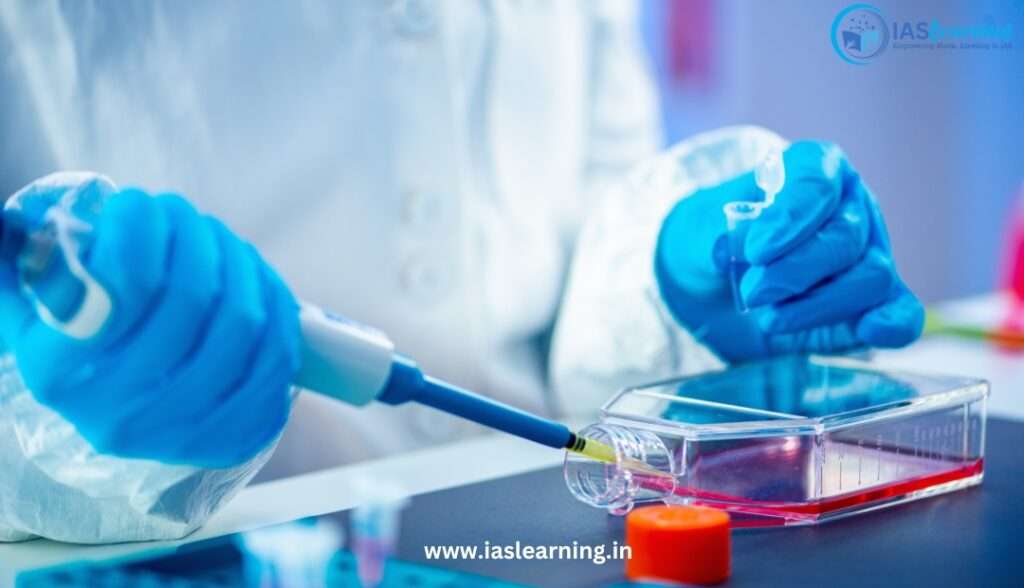
The Department of Biotechnology manages most of the programmes of biotechnology sector in India. It is under the Ministry of Science and Technology Its objectives are:
- To provide services in the areas of research, infrastructure, generation of human resource, popularization of biotechnology, promotion of industries, creation of centers of excellence
- Implementation of biosafety guidelines for genetically modified organisms, recombinant DNA products and biotechnology-based programs for societal benefits.
- To establish an information network for the Bioinformatics mission of India in the scientific community, nationally and internationally.
| Genetic Engineering Appraisal Committee (GEAC): Applications of Biotechnology |
| The GEAC functions under the Ministry of Environment, Forest and Climate Change (MoEF&CC).It is responsible for the appraisal of activities involving large-scale use of hazardous microorganisms and recombinants in research and industrial production from the environmental angle.The committee is also responsible for the appraisal of proposals relating to the release of genetically engineered (GE) organisms and products into the environment including experimental field trials.GEAC is chaired by the Special Secretary/Additional Secretary of MoEF&CC and co-chaired by a representative from the Department of Biotechnology (DBT). |
- Recently, the Society of Biotechnology of India (SBPI) promoted transformation changes and approaches towards core research in modern biotechnology so that the outcome could lead to more products and technologies for economic and social gain.
- The programs undertaken in agriculture are
- Wheat Genome Sequencing Programme
- Rice Functional Genomics
- Crop Biofortification and quality improvement programme
- National Plant Gene Repository programme
- Next Generation Challenge Programme on Chickpea Genomics,
- Utility in public health and nutrition are
- Addressal of micronutrient deficiencies, severe acute malnutrition, food fortification, probiotics for human health and well-being, food safety, molecular detection of GM traits in foods.
- Development of low-cost foods/supplements and utilization of agricultural residues for value added products.
- Capacity building in Food Science and Nutrition Biology.
Conclusion: Applications of Biotechnology
Applications of biotechnology could be a major tool for development in all countries. Entwined with culture and socio-ethical values, biotechnology could be utilised in solving future problems like food and water insecurity that impede national development and threaten peace in the developing world.
